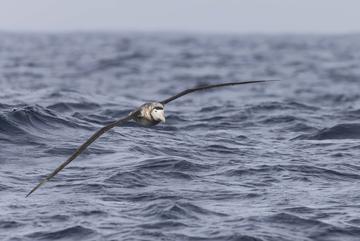Flying above the ocean, fishing boats can look like an opportunity for an easy meal for seabirds; but getting caught on hooks, entangled in nets, or injured by cables is an all-too frequent threat. All over the world, seabirds are threatened due to interaction with fisheries. Bycatch can lead to hundreds of thousands of seabird deaths every year, and tube-nosed birds like albatrosses and petrels are particularly at risk.

Image: Oscar Thomas
By tagging birds with GPS trackers to see which fisheries they interact with during their time at sea, scientists can study this risk – but this tracking is rife with uncertainty. If one location is recorded every two hours, how can we be sure where the bird flew during each two-hour gap? What are the chances that it approached a nearby fishing vessel, if that vessel also has two-hour gaps between its GPS locations?
New research has come up with a way to fill these literal research gaps: time geography. If the maximum speed of a bird (or vessel) is known, there is a limited area within which it must have been between each GPS location. The team overlapped these areas to calculate the probability that a bird flew close enough to a vessel to be at risk of bycatch, measuring the uncertainty of seabird-vessel interaction.
The researchers tracked two individual Antipodean albatrosses (Diomedea antipodensis antipodensis), known as Toroa in Te Reo Māori. This endangered species, endemic to Aotearoa New Zealand, is highly threatened by bycatch in fisheries. They also tracked fishing vessels that were in the same general area, and calculated how long, and with what probability, each bird interacted with vessels in its vicinity. Their results provide a striking view of how albatrosses can follow fishing vessels for hours at a time; one bird followed a single vessel for between 6 and 14 hours.
“At first glance, this result is concerning because it shows that albatrosses can be at high risk of bycatch for long periods of time,” said Jonathan Rutter, lead author of the study. “However, the true importance of this finding comes in the fact that we have a range of numbers. There is a 97.5% chance that attendance lasted for at least 6 hours, and a 2.5% chance that it lasted for at least 14 hours. Previously, we might have just shared a number in the middle, such as 10 hours, without any idea how uncertain that number was. Now, we can quantify that uncertainty.”
By measuring the uncertainty of seabird-vessel interactions, time geography can help to improve bycatch risk assessments for seabird species around the world – particularly when seabird or vessel tracking data has large or inconsistent gaps between locations. The method does not even need to be limited to seabird-fishery interactions; manatees at risk of boat strikes, deer at risk of vehicle collisions, or tour boats trying to increase whale watching success – many research questions involve uncertain interaction between two moving objects.
There are several ways of reducing seabird bycatch, from night setting of fishing gear to weighting of longlines, but uptake and implementation are often insufficient. This study provides a new tool to inform efforts to increase bycatch mitigation worldwide.
“Our approach could empower management of a threat that is inherently uncertain, to ensure a less uncertain future for seabirds.”
Jonathan is a DPhil student in Biology, who completed this research as part of his Masters in the School of Geography & the Environment.
This research was a collaboration with BirdLife International and the New Zealand Department of Conservation.
To read more about this research, published in Animal Conservation, visit: https://www.doi.org/10.1111/acv.12961